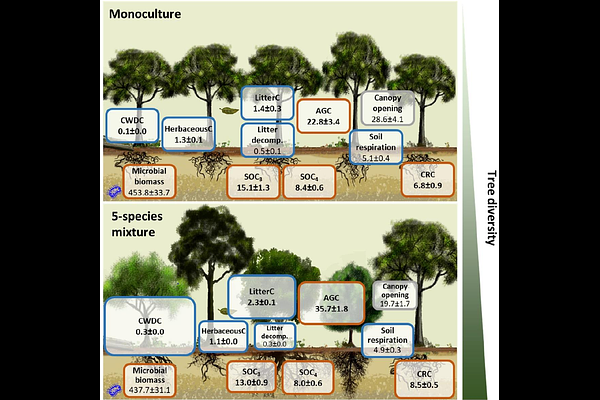Tree diversity increases carbon stocks and fluxes above- but not belowground in a tropical forest experiment

Tree diversity increases carbon stocks and fluxes above- but not belowground in a tropical forest experiment
Schnabel, F.; Guillemot, J.; Barry, K. E.; Brunn, M.; Cesarz, S.; Eisenhauer, N.; Gebauer, T.; Guerrero-Ramirez, N. R.; Handa, I. T.; Madsen, C.; Mancilla, L.; Monteza, J.; Moore, T.; Oelmann, Y.; Scherer-Lorenzen, M.; Schwendenmann, L.; Wagner, A.; Wirth, C.; Potvin, C.
AbstractInternational commitments advocate large-scale forest restoration as a nature-based solution to climate change mitigation through carbon (C) sequestration. Mounting evidence suggests that mixed compared to monospecific planted forests may store more C, exhibit lower susceptibility to climate extremes and offer a broader range of ecosystem services. However, experimental studies comprehensively examining the control of tree diversity on multiple C stocks and fluxes above- and belowground are lacking. To address this gap, we leverage data from the Sardinilla experiment in Panama, the oldest tropical tree diversity experiment which features a gradient of one-, two-, three-, and five-species mixtures. Over 16 years, we measured multiple above- and belowground C stocks and fluxes, ranging from tree aboveground C, over leaf litter C production, to soil organic carbon (SOC). We show that tree diversity significantly increased aboveground C stocks and fluxes, with a 57% higher gain in aboveground tree C in five-species mixtures compared to monocultures (35.7{+/-}1.8 vs 22.8{+/-}3.4 Mg C ha-1) 16 years after planting. In contrast, we observed a net reduction in SOC (on average -11.2{+/-}1.1 Mg C ha-1) and no significant difference in SOC3 stocks (the tree-derived SOC fraction) between five-species mixtures and monocultures (13.0{+/-}0.9 vs 15.1{+/-}1.3 Mg C ha-1). Positive tree diversity effects persisted despite repeated climate extremes and strengthened over time for aboveground tree growth. Higher tree growth in mixtures enhanced leaf litter and coarse woody debris C fluxes to the soil, resulting in a tightly linked C cycle aboveground. However, the only link between above- and belowground C stocks and fluxes was between leaf litter C inputs and SOC3 which was positively affected by diversity. Our study elucidates the mechanisms through which higher tree diversity bolsters the climate mitigation potential of tropical forest restoration. Restoration schemes should prioritize mixed over monospecific planted forests.